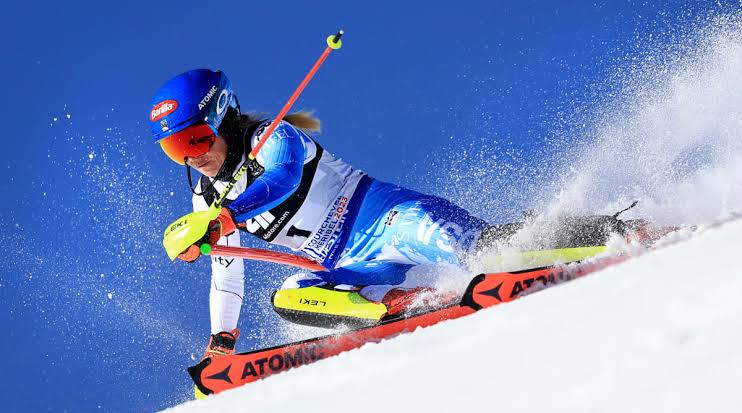
Mikaela Shiffrin on the Most Difficult and Bad Skiing Locations: A Champion’s Perspective
Mikaela Shiffrin, the most dominant force in modern skiing, has been open about the many challenges she faces on the slopes. While her unmatched skill has earned her countless titles, Shiffrin has spoken candidly about some of the most difficult skiing locations she has encountered. These are places where the terrain, weather, or even psychological barriers push athletes to their limits. As she continues to redefine the sport, Shiffrin’s insights provide a rare look at what makes certain locations especially tough, and sometimes outright bad, for skiers—even for someone of her caliber.
The Alpine Gauntlet: Nature’s Unforgiving Terrain
Not all skiing locations are created equal, and Mikaela Shiffrin has faced some of the harshest conditions the world has to offer. While many skiers look forward to the picturesque beauty of mountains like Aspen or Kitzbühel, Shiffrin’s career has taken her to some of the most treacherous environments.
One of the most infamous skiing locations Shiffrin has opened up about is Cortina d’Ampezzo in Italy. Known for its stunning views and sharp, punishing turns, the conditions in Cortina can range from dangerously icy to slushy within the same day. Athletes are forced to adapt quickly, and one mistake can cost a race. Shiffrin herself has experienced frustration on this slope, having once described the conditions as a “mental battlefield.” The unpredictability of the weather—sudden gusts of wind or fog rolling in during key moments of the race—compounds the challenge, making Cortina one of the most notoriously difficult World Cup stops.
In St. Moritz, Switzerland, Shiffrin has faced equally tough conditions. The snow here can often be bulletproof—so icy that even the sharpest of edges struggle to grip. Shiffrin has mentioned that when the surface is too slick, skiers spend more energy trying to maintain balance and speed than focusing on technique. St. Moritz, with its hard-packed snow and variable conditions, is a place where even the smallest mistake can result in a loss of control, and crashes are common. The pressure to perform on such challenging surfaces can make the mental aspect of racing overwhelming.
Psychological Barriers: The Weight of Expectations
While the physical demands of these locations are undeniable, Shiffrin often discusses how the psychological aspect of skiing can make already tough locations even worse. For her, it’s not just about the mountain itself—it’s about the headspace you’re in when you compete. She has spoken about the mental toll that skiing in high-stakes races can take, especially when expectations are sky-high.
Take Kitzbühel, Austria, for instance, often hailed as the most difficult downhill course in the world. For skiers, Kitzbühel represents the ultimate test of bravery. The downhill course, known as the Streif, is infamous for its sheer drops, narrow paths, and bone-chilling speeds. The psychological pressure of competing on a slope where a single miscalculation can lead to devastating injuries adds a whole new dimension to the difficulty. Shiffrin has confessed that this race makes her more nervous than others because of the danger involved. When the conditions are less than ideal—snowstorms, visibility issues, or sheer ice—this race becomes an even more daunting challenge.
Beyond Kitzbühel, there are lesser-known locations that Shiffrin finds mentally draining. Val d’Isère in France, for example, is a technical course that requires intense focus and precision. Shiffrin has said that the relentless turns and rapid changes in elevation can leave a skier mentally exhausted before they even finish. Unlike the glamour of better-known venues, Val d’Isère is not forgiving. Skiers need to be on their A-game, and any lapse in focus can spell disaster.
Bad Days on Bad Slopes: When Everything Goes Wrong
Shiffrin is no stranger to bad days, even on slopes that she once dominated. In interviews, she has talked about how conditions at even her favorite locations can turn into nightmares. Take Levi, Finland, where she’s had significant success. Known for its long, technical runs, Levi has also given Shiffrin some of her most frustrating days. In one race, the weather changed so drastically that a perfectly prepared course turned into a rough, uneven track by the time she competed. She’s admitted that skiing in such deteriorating conditions makes it feel less like a race and more like surviving until the finish line.
Another location that Shiffrin has expressed frustration with is Lake Louise, Canada. Though it holds a place of prestige in the ski world, Shiffrin has mentioned how the course’s long, flat sections can disrupt rhythm. More than once, she’s lost time on these flatter parts, where maintaining speed is essential but difficult, given the course design and sometimes inconsistent snow conditions. What might seem like an easier course to some has proven to be deceptively tough, as even the slightest misjudgment can throw off an entire run.
The Strain of Travel: Skiing in Less-than-Ideal Conditions
Skiers like Mikaela Shiffrin spend much of their year on the road, competing at various locations across the globe. Not every venue offers the pristine conditions seen in iconic European resorts. Shiffrin has shared that in some lesser-known venues, especially those in the Southern Hemisphere or regions where snow is unpredictable, the conditions can be abysmal.
In particular, Shiffrin has commented on her experiences in New Zealand during training sessions. While the Southern Hemisphere offers skiers the chance to train during the off-season, the inconsistent snow quality and high winds make for less-than-ideal skiing environments. This lack of predictability can turn a training session into a hazardous ordeal, forcing skiers to tread cautiously when they’d prefer to be pushing their limits.
Another challenge is skiing in North American locations, where late-season races sometimes feature slushy, rapidly melting snow. Shiffrin has been vocal about how such conditions make the skiing feel more like “water skiing,” with athletes fighting to stay upright rather than competing for the fastest time. The unpredictability of weather, especially at spring events in locations like Squaw Valley, can sometimes make races feel more like a lottery than a showcase of skill.
The Final Word: Navigating the Good and the Bad
Mikaela Shiffrin’s willingness to open up about the bad and difficult skiing locations offers a rare glimpse into the mindset of a champion. Despite the harsh conditions, she continues to prove herself at every turn, adapting and excelling even on the most challenging of slopes. Her reflections on these courses, from the icy dangers of St. Moritz to the psychological grind of Kitzbühel, remind us that skiing is not just about skill but also about mental fortitude. Shiffrin’s career is a testament to what it takes to succeed at the highest levels—even when the odds, and sometimes the mountains, are against you.





